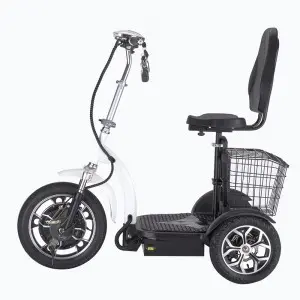Mobility scooters have become a popular mode of transportation for people with limited mobility. These electric vehicles provide a convenient and efficient way for people with disabilities to travel and maintain their independence. However, a common question arises: “Can I use a mobility scooter if I don’t have a disability?” This article aims to address this question and provide insights into the use of mobility scooters for non-disabled people.
Mobility scooters are designed to assist people with mobility impairments, such as those with physical disabilities, injuries, or medical conditions that affect their ability to walk or move easily. These devices provide a practical solution for people who may have difficulty navigating public spaces or carrying out daily activities without assistance. However, the use of mobility scooters is not limited to people with disabilities. In fact, many people without disabilities find these vehicles a convenient and practical means of transportation.
One of the main reasons people with disabilities choose to use a mobility scooter is to increase mobility and independence. For example, older adults who may have difficulty walking long distances or standing for long periods of time may benefit from using a mobility scooter to get through shopping malls, parks, or other public areas. Additionally, people with temporary injuries or medical conditions that affect their mobility, such as a broken leg or chronic pain, may also find that a mobility scooter can be a helpful aid in their recovery process.
It is important to note that people without disabilities should use mobility scooters with consideration and respect for those who rely on these devices for their daily mobility needs. While there are no specific laws or regulations prohibiting the use of mobility scooters by non-disabled people, it is crucial that these vehicles are used responsibly and ethically. This includes looking out for accessible parking spaces, pathways and facilities designed for people with disabilities.
Additionally, individuals who choose to use non-disabled mobility scooters should familiarize themselves with the proper operation and safety guidelines for these vehicles. It is essential to be trained on how to operate a mobility scooter safely, including understanding the controls, maneuvering techniques, and observing traffic rules and pedestrian etiquette. By doing this, non-disabled people can ensure they use mobility scooters in a way that promotes safety and consideration for others.
In some cases, non-disabled people may face criticism or judgment for using a mobility scooter. It is important to recognize that perceptions and attitudes towards the use of walking aids may vary and individuals should approach the situation with empathy and understanding. While some may question the legality of accessible use of mobility scooters, others may acknowledge the practical benefits and reasons for doing so.
Ultimately, a non-disabled person’s decision to use a mobility scooter should be based on genuine need and consideration for others. It’s important to assess your own mobility limitations and determine whether a mobility scooter can truly enhance independence and accessibility in your daily life. Additionally, open communication and respect for people with disabilities who rely on mobility scooters can help create a supportive and inclusive environment for all users of these devices.
In conclusion, the use of mobility scooters by non-disabled persons is an important consideration that requires accessibility, respect and responsible use. While e-scooters are primarily designed to assist people with disabilities, people without disabilities may also find practical benefits in using these vehicles to increase mobility and independence. It is critical for individuals who choose to use accessible mobility scooters to handle the situation with empathy, respect, and a commitment to using these devices responsibly. By doing so, all users can contribute to creating a more inclusive and supportive environment for individuals with different mobility needs.
Post time: May-13-2024



